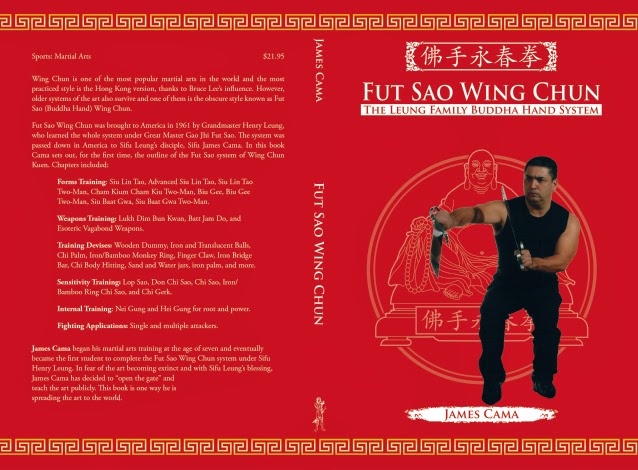 Tambuli Media’s latest offering by James Cama offers a glimpse into the little seen world of the Leung Family Buddha Hand System of martial arts with “Fut Sao Wing Chun.” A 115 page overview of a little known branch of the Southern Chinese Martial art known as Wing Chun, a system renown for its pragmatic approach to self defense and health.
Tambuli Media’s latest offering by James Cama offers a glimpse into the little seen world of the Leung Family Buddha Hand System of martial arts with “Fut Sao Wing Chun.” A 115 page overview of a little known branch of the Southern Chinese Martial art known as Wing Chun, a system renown for its pragmatic approach to self defense and health.
The author, James Cama, offers a brief historic overview of the art before leading the reader through the various aspects of Wing Chun. Subjects such as weapons, empty hand forms, internal healing (nei gung), and two person form are touched upon. Cama also shows a taste of the self defense aspects that Wing Chun has to offer. Unfortunately these are mere appetizers to the uninitiated! Though written decently it almost seems rushed as I was left wanting more details on every aspect; lineage, pedagogy, mindset of a Wing Chun fighter; how to deal with specialists in other methods of combat etc.etc. A smattering of self defense scenarios are presented but little explanation is offered. For instance on page 106 the author talks about the importance of controlling the opponents energy in a self defense situation. But ultimately this is merely a maxim as their is no further details offered nor explanation.
Edited well the photo’s are well lit and clear, offering a single angle on the subject in most instances. The form stills are solid and clear though again only offering one angle, not multiples. The reader is left yearning for more info and depth unless of course you already practice the Buddha Hand system of the Leung Family. To those practitioners this book is of the most value since Cama offers the basic forms broken down into over 200 photos as well as the two person set. A wonderful source of the movements to any student of the art.
The Hei Gong (nei gung) form is also presented (and to the best of my knowledge this is the first time it appears openly in print). A strong, powerful healing set that combines breath work with dynamic movements and mental acuity training.
One is left feeling as if there must be a follow up volume diving into more details of such a rare art, but that desire is overshadowed by the sad fact that James Cama unexpectedly passed on the day this title was in fact published. A legacy cut short for sure but none the less one cemented in the foundation of time with this text as a treatise to his past for the students of the future.
Fut Sao can be purchased by clicking here.
